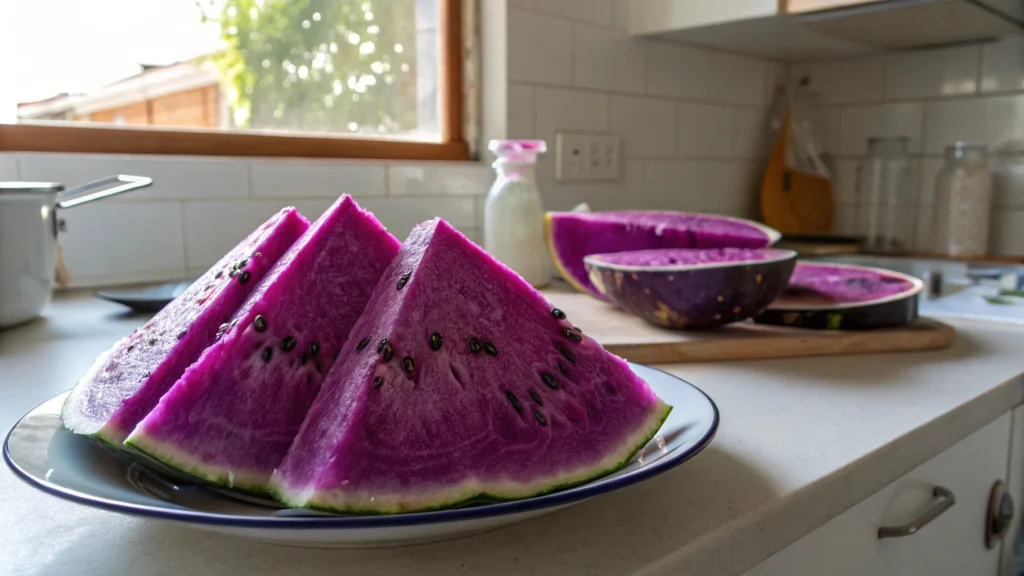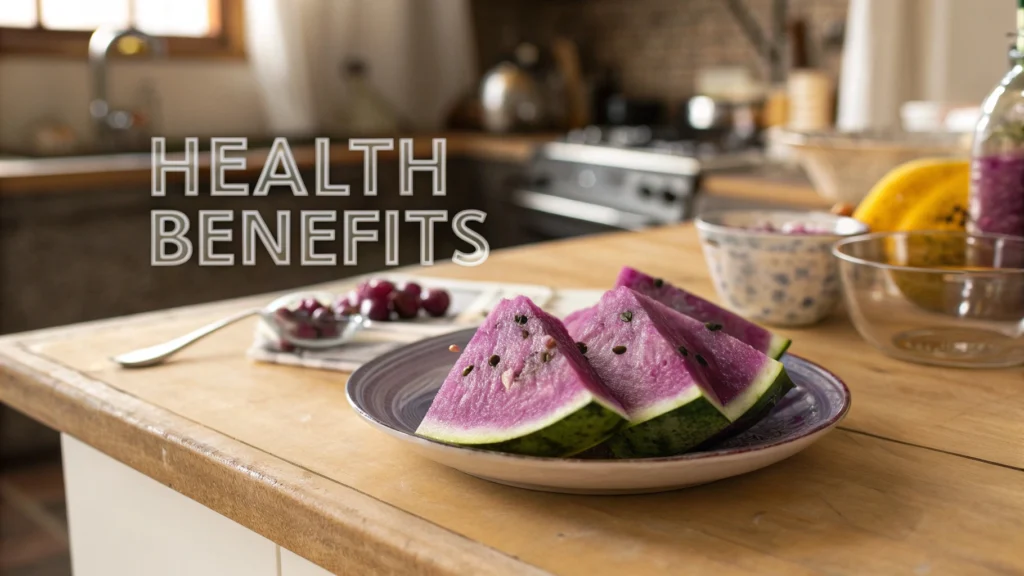Purple Watermelon: Nature’s Most Mysterious Fruit
Have you ever imagined biting into a purple watermelon bursting with flavor like nothing you’ve experienced before? Unlike traditional watermelons with green-striped exteriors and pink flesh, this stunning variety features vibrant violet flesh that captivates both the eyes and taste buds. More than just a visual delight, purple watermelons boast enhanced nutritional benefits, including rich antioxidants, making them a standout among watermelon varieties. Whether you’re a food enthusiast eager to try something new or a gardener looking to diversify your patch, this extraordinary fruit offers a unique opportunity to experience nature’s creativity. Perfect for brightening up any plate or sparking conversation at gatherings, these melons are revolutionizing the way we think about summer fruit. Explore the fascinating world of purple watermelons and discover how they combine beauty, flavor, and health benefits in one remarkable package. Nature never ceases to amaze, and this fruit is proof!
“Find more delicious and unique watermelon varieties, explore our article on Yellow Watermelon: A Complete Guide to This Sweet Fruit. Discover how this sunny-hued fruit adds a sweet twist to your summer dishes!”
The Fascinating Discovery of Purple Watermelon Varieties

Origins and Development of Violet-Fleshed Cultivars
Let’s dive into an amazing journey that started in a small watermelon patch! While traditional green watermelons have been around forever, the story of the purple watermelon began quite differently. Scientists first noticed unusual color variations while studying different types of watermelon in remote farming regions. Unlike the typical pink-meated watermelon or even the surprising yellow watermelon varieties, these special melons showed hints of violet flesh. This discovery sparked a worldwide hunt for similar varieties, leading researchers through various watermelon patches across different continents. Through careful breeding and selection, they began developing what we now know as purple watermelons. The process wasn’t quick or easy, but the results were worth it! These unique fruits now stand alongside traditional green-skinned and yellow-fleshed varieties, adding an exciting new chapter to the watermelon’s colorful background.
Scientific Breakthrough in Natural Fruit Pigmentation
The science behind watermelon colors is absolutely fascinating! When researchers first examined these unique melons, they found something incredible about their flesh color. The purple watermelon gets its distinctive hue from special plant compounds called anthocyanins – the same stuff that makes blueberries blue! This was a huge breakthrough in understanding how different kinds of watermelon develop their colors. Unlike the familiar pink meat watermelon or the lesser-known yellow varieties, these purple beauties produce these pigments naturally. Scientists discovered that specific genes control this process, similar to how original watermelon varieties got their classic red color. What’s super cool is that these pigments aren’t just for show – they actually serve a purpose! The discovery opened up new possibilities for developing other colorful fruit varieties.
Health Benefits That Set These Melons Apart

Unique Antioxidant Properties of Purple Flesh
Get ready to be amazed by what makes purple watermelon extra special! This isn’t just any ordinary melon we’re talking about. The same compounds that give it that gorgeous purple color are packed with amazing health benefits. Think of it as a super-powered version of your regular watermelon! The purple flesh contains way more antioxidants than traditional pink or yellow watermelon varieties. These little warriors help protect your body’s cells, like tiny shields fighting off the bad stuff. What’s really cool is that these purple beauties pack a bigger health punch than many other fruits. Plus, they’re just as refreshing and juicy as the watermelons you already know and love. It’s like getting an upgrade on your favorite summer fruit!
“If you’re wondering whether watermelons are safe for your furry friends, check out our guide on Can Dogs Eat Watermelon? for everything you need to know.”
Comparing Nutritional Profiles with Traditional Varieties
Let’s break down what makes these colorful watermelons so special in the nutrition department! When you compare different types of watermelon side by side, the purple variety really stands out. Unlike traditional pink-meated watermelon or yellow watermelon varieties, these violet wonders pack extra nutrients. They’ve got all the good stuff you’d expect from any watermelon, plus bonus health perks! While green watermelons are already super healthy, their purple cousins take things to the next level. They’re loaded with vitamin C, just like original watermelon, but with added antioxidants. Think of it as nature’s way of giving you more bang for your bite! The best part? You get all these extra benefits while enjoying the same sweet, refreshing taste you love.
Growing Your Own Violet Wonder at Home
Essential Cultivation Requirements for Success
Ready to turn your watermelon patch into something extraordinary? Growing purple watermelon is easier than you might think! First off, these special melons need lots of sunshine, just like their green and yellow watermelon cousins. The key is starting with rich, well-draining soil – think of it as making a cozy bed for your future fruits. You’ll want to space your plants about six feet apart, giving them plenty of room to spread out and grow. Just like other kinds of watermelon, these purple beauties are thirsty plants, so regular watering is super important. The exciting part is watching the fruit develop its unique color! Keep an eye on your growing melons, and soon you’ll have your very own patch of these mysterious fruits.
Common Challenges and Solutions in Purple Melon Gardening
Don’t worry if you hit a few bumps while growing these special melons – every gardener does! The most common challenge when growing purple watermelon is getting the timing right. Unlike traditional meated watermelon varieties, these need a bit more patience. Sometimes the color development can trick you – it’s different from watching a green watermelon or yellow watermelon mature. But here’s a fun tip: tap the melon gently and listen for a hollow sound. Another tricky part can be protecting the fruits from too much sun, which might affect their unique color. A simple solution is providing some shade during the hottest part of the day. Remember, each watermelon patch is different, so what works in one garden might need tweaking in another.
From Farm to Table: Harvesting and Selection Tips
Identifying Peak Ripeness in Specialty Melons
Here’s the fun part – learning how to pick the perfect purple watermelon! Unlike picking original watermelon varieties or yellow-meated melons, these unique fruits have their own special signs of ripeness. First, check out the spot where your melon sits on the ground – it should be creamy yellow, not white. The overall watermelon color might trick you since it’s different from traditional green watermelon varieties. Give it a gentle tap – a ripe one sounds hollow, just like other types of watermelon. The stem should be brown and slightly dried out. Here’s a cool trick: if you’re growing different kinds of watermelon together, remember that purple varieties might ripen a bit differently than their cousins.
Storage Methods to Preserve Color and Flavor
Let’s talk about keeping your purple watermelon fresh and fabulous! Storing these special melons takes a bit more care than traditional watermelon varieties. First, find a cool spot – around 55 degrees is perfect. Unlike yellow watermelon or regular green watermelon, the purple variety can be a bit more sensitive to temperature changes. Here’s a neat trick: if you’ve got multiple types of watermelon, store them separately to maintain their unique colors and flavors. Whole melons can last about two weeks when stored properly. Once you cut into that beautiful purple flesh, try to use it within 3-4 days. Keep cut pieces in an airtight container in the fridge. The color might intensify a bit in storage – that’s totally normal for these special melons!
Creative Ways to Enjoy This Exotic Fruit
Culinary Applications and Recipe Ideas
Time to get creative with your purple watermelon in the kitchen! Unlike traditional meated watermelon or yellow varieties, these violet beauties can transform ordinary dishes into spectacular treats. Try cubing it for a show-stopping fruit salad – the purple chunks look amazing next to other watermelon colors! Here’s a fun idea: freeze small pieces for natural ice cubes that slowly tint your drinks purple. You can blend it into smoothies for a gorgeous purple hue that’ll wow your friends. The flesh works great in salsas too, adding unexpected color to your favorite recipes. Want something really different? Try grilling thick slices – just like you would with other kinds of watermelon, but with an extra special twist. The heat brings out amazing flavors while maintaining that beautiful color!
Presentation Tips for Maximum Visual Impact
Let’s make your purple watermelon the star of the show! When it comes to presentation, these unique melons offer endless possibilities that regular green watermelon or yellow varieties can’t match. Start by cutting clean, precise slices to showcase the stunning violet flesh – it’s an instant conversation starter! Try arranging different types of watermelon together for a rainbow effect: combine traditional pink, yellow, and purple varieties for an eye-catching display. Create fun shapes using cookie cutters, or carve the rind into decorative patterns. For parties, hollow out half a melon to make a natural purple bowl! The vibrant color makes every dish look more exciting. Remember, people eat with their eyes first, and these watermelon colors never fail to impress!
Frequently Asked Questions (FAQs)
FAQ 1
Yes, purple watermelon exists through special breeding programs! These unique melons were developed by scientists who worked on creating new varieties. While they’re not as common as regular watermelons, they’re real and growing in popularity. Their purple flesh comes from special plant compounds called anthocyanins, the same stuff that makes blueberries blue.
Originally, watermelons had a pale pink flesh with lots of seeds. Nature made them this way! Through years of farming and breeding, we now have the bright red color we know today. It’s amazing to think that all our colorful varieties – red, yellow, and even purple watermelons – came from this humble beginning.
The rarest type is actually the purple watermelon! These special melons are hard to find because they’re newer and not grown as widely as other varieties. While yellow watermelons are also uncommon, the purple variety takes the crown for being the most unusual and sought-after type.
You’d be amazed at the rainbow of watermelon colors out there! Besides the traditional pink-red flesh, we have yellow watermelons, orange varieties, and even purple ones. The outside can be dark green, light green, or even yellow-striped. In total, there are about 5-6 main flesh colors and various rind patterns.
FAQ 2
Yes, golden (or yellow) watermelon is totally real! These sunny-colored melons aren’t dyed or modified – they’re naturally yellow inside. They taste a bit like honey and are just as juicy as red watermelons. While not as common as traditional varieties, they’re becoming more popular in gardens and markets.
Yes, but they’re not actually black inside! Some watermelons have very dark green, almost black-looking rinds. These are often Japanese varieties like Black Diamond. The flesh inside is usually bright red or pink. They’re different from purple watermelons, which have colorful flesh but normal-looking rinds.
Pink watermelons are the most common type you’ll find! They’re what most people think of as “regular” watermelons. The flesh can range from light pink to deep rose red. These are the traditional favorites you’ll find in most stores and gardens, loved for their sweet, refreshing taste.
Yes, white-fleshed watermelons do exist! They’re sometimes called Early White Small or White Wonder. The flesh looks creamy white and has a crisp, mild taste. While not as sweet as red or purple watermelon varieties, they’re perfect for people who prefer less sugary fruits.
FAQ 3
Each color offers something special! Red varieties are sweetest, yellow ones taste like honey, and purple watermelons pack extra health benefits. The “best” really depends on what you like. For nutrition, purple watermelons lead the pack , For classic sweetness, go red and For unique flavor, try yellow!
The Japanese Densuke watermelon holds this title! It’s a rare black-rinded watermelon that can cost over $200 per melon. While purple watermelons are also premium fruits, they’re not quite as pricey. These luxury melons are grown in limited quantities and are often given as special gifts.
Rainbow watermelon isn’t one variety – it’s actually a fun way to serve different colored watermelons together! By combining regular red, yellow, and purple watermelon pieces, you can create beautiful rainbow displays. It’s perfect for parties and makes fruit salads look amazing.
Black watermelons, especially Japanese Densuke varieties, are expensive because they’re super rare! They only grow in specific places and farmers take extra special care of each melon. Like purple watermelons, they’re considered luxury fruits. Plus, they’re often perfectly round and extra sweet, making them even more special.
Transform Your Garden and Plate with This Remarkable Fruit
Embark on an exciting journey into the world of growing purple watermelons! These stunning fruits are more than just visually striking; they bring beauty and exceptional nutrition to your table. Whether you’re a seasoned gardener or a beginner, cultivating these violet wonders is a rewarding experience. Their vibrant color is sure to spark conversations at summer gatherings, while their health benefits outshine traditional varieties. Every great garden begins with a single seed, and your purple watermelon patch could be next. Start small, embrace the learning process, and enjoy the adventure. There’s nothing more satisfying than harvesting your very own purple watermelons and sharing their beauty and flavor with loved ones. Once you see these unique fruits flourishing in your garden, you’ll wish you had planted them sooner. Dive in and discover the joy of growing this extraordinary fruit!
